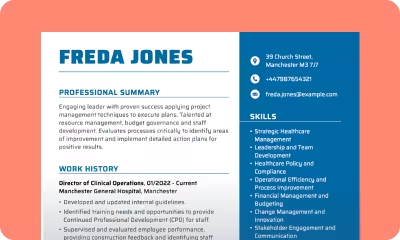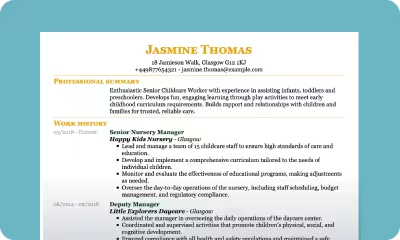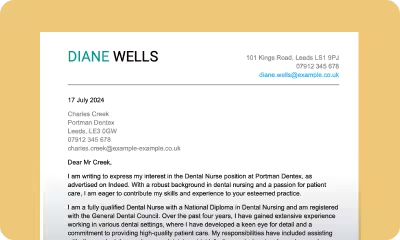- Our customers have been hired by : *Foot Note
A career change cover letter is your opportunity to introduce yourself to potential employers in a completely new field you’re entering, and to make a lasting impression even without a strong industry-specific experience. Instead, a cover letter for career change highlights your transferable skills, demonstrates your enthusiasm, and explains why you’ve decided to change careers.
Whether you’re looking for a job in marketing or the culinary arts, you can use our cover letter examples and templates to impress employers and showcase your relevant achievements. With a step-by-step writing guide and our cover letter builder, which you’ll find below, you’ll have everything you need to stand out and break the ice on a new career path.
Career Change Cover Letter Sample
Hannah Taylor
24 Jones Walk
Sheffield S2 2FJ
07912 345 678
hannah.taylor@example.co.uk
20 October 2024
Edward Wallace
Fit & Easy
Sheffield S1 5EH
contact@fitandeasyltd.co.uk
Dear Mr Wallace,
I’m writing to apply for the Project Coordinator position at Fit & Easy. With a background in IT support and a passion for nutrition, I know I can be a valuable asset to your team. During the past four years, I’ve developed strong problem-solving and multitasking skills. I’m also familiar with process improvement principles and can work under tight deadlines.
In my current position, I’ve been responsible for resolving technical support issues, coordinating initiatives with cross-functional teams, and ensuring timely delivery of monthly and quarterly IT support reports. I have also gained experience necessary for project coordinators, which included undergoing training in using project management software, such as Jira and Asana.
While I enjoyed my time as a member of an IT support team, my growing interest in health and wellness has inspired me to transition into a role more aligned with my passions. I’m confident that my teamwork skills and the ability to work collaboratively will contribute to your team’s success.
A copy of my CV is enclosed. Thank you for your time and consideration. I look forward to speaking with you directly during a job interview. Do not hesitate to contact me if you have any further questions about my qualifications.
Yours sincerely,
Hannah Taylor
How to Write a Cover Letter for a Career Change
If you’re looking to move into a completely new industry, crafting a strong application is an essential step in securing your dream job. With no role-specific experience, a cover letter for a career change emphasises your transferable skills and demonstrates your learning potential. It’s also a great chance to showcase your passion and creativity, making a lasting impression on the potential employer.
Thanks to our in-depth guide, you’ll learn how to demonstrate that you’re the right fit while effectively communicating your motivation for the career transition. You’ll also learn how to highlight relevant skills that match the requirements of the new role, connecting the dots between your current and future career. Additionally, we’ll give you tips on how to incorporate role-specific terminology to show your familiarity with the new field.

Here’s a step-by-step guide to help you craft an effective cover letter to facilitate a career change:
Step 1: Identify the skills necessary for your career change
Prepare to write your cover letter by identifying the essential skills for your new career path. You can divide your skills research into two parts. Start by identifying hard skills that are specific to the new role. For example, if you’re applying for a job in marketing, it’s useful to know how to use Google Analytics and marketing reporting software. Then move on to identifying the key interpersonal skills for the role, such as teamwork, communication, and adaptability.
To make this process easier, you can approach writing your career change cover letter by learning how to write a cover letter with no experience. Review the typical requirements employers have for the role you want to secure and study the vacancy in detail. Be concise, focused, and make sure your application is tailored to the specific job. Always do your research before crafting a CV and cover letter, as this will facilitate a smoother career transition and long-term success.
Step 2: Add a contact section to your cover letter
Start your cover letter with your details. Write your full name, address, phone number, and address. Make sure this section matches the information from your CV. Next, write today’s date. In a new paragraph, include the recipient’s details. If possible, identify them and include their name. This makes your career change cover letter feel more personal and shows your determination.
Colleen James
217C Fairey Street
Birmingham B45 8GWA
20 October 2024
Georgia Smith
Flowers & Books
Birmingham b2 C6VB
hr@flowersandbooks.co.uk
Step 3: Address the recipient of your career change cover letter
Personalise your letter by choosing an appropriate greeting that matches the recipient’s details from the contact section. If you know their name, use it in the greeting, as it shows that you have spent some time researching the company. If you’re unsure of the recipient’s preferred pronouns, avoid using an honorific such as “Mr” or “Ms”. Instead, use the full name of the person you’re addressing.
If you can’t determine the recipient’s name, it’s fine to use a generic greeting. The only thing to remember is that it’s best to avoid using “To Whom It May Concern”, as many people consider it outdated.
Dear Ms Smith,
OR
Dear Hiring Team,
Step 4: Write a strong introduction to support your career transition
Writing a strong introduction increases your chances of grabbing the recruiter’s attention. Making the first two or three sentences of your letter stand out also increases the likelihood that they’ll read through your entire application. Start your introduction by stating why you’re writing. Mention the name of the position for which you’re applying and the name of the company. Then go on to introduce yourself professionally.
To effectively support your decision to change careers, your introduction should immediately highlight your enthusiasm and transferable skills. For example, you could describe how your plans for the future align with what the role requires or offers. Be concise and to the point, as you’ll later (in the body of the letter) describe in more detail how your background has prepared you for this transition.
I’m writing to express my interest in the Marketing Coordinator position at Marketers International. With over four years of experience as a secondary school teacher, I’m eager to use my leadership and organisational skills to transition from education to marketing. I’m passionate about storytelling and have developed strong communication skills. I strongly believe that my background and passions will make me a valuable addition to your team.
OR
I’m thrilled to apply for the Data Analyst position at DataPoint. With a solid foundation in finance, earlier this year I made the decision to pursue a career in data analysis, which aligns with my analytical mindset and data-centric approach to completing tasks. I’m particularly impressed by DataPoint’s innovative use of data to inspire business decisions, which makes me excited about the opportunity to contribute to your team’s success.
Step 5: Explain why you’ve decided to change your career
The body is likely to be the longest part of your cover letter. Use this section to include any information about your background that’s relevant to the job you want to secure, and to explain why you’re changing careers. Remain professional and focus on the professional aspects of the transition. From a recruiter’s perspective, good reasons for changing careers include seeking new workplace challenges, demonstrating a desire to develop skills, or pursuing passions.
When you’re discussing this, make sure you use some role-specific terminology, or keywords, that the ATS will notice. These keywords will vary depending on the position and industry. For example, good keywords to include if you’re applying for a job in education include lesson planning and test marking, whereas for an administrative role you might want to include office management, data entry, and record keeping.
After working as a secondary school teacher for five years, I’ve decided to transition into a role in educational administration. I believe that this will allow me to take on new challenges and make a stronger impact on the institution’s long-term success. My experience in lesson planning has equipped me with strong organisational and project management abilities. I’m eager to apply this knowledge in an administrative role.
In my current position, I helped the school implement new curriculum development policies, which showed my initiative and analytical thinking. That experience sparked my interest in maintaining a positive school culture. I’m particularly drawn to working in educational administration because it will allow me to help shape the way in which the school operates while making its environment comfortable for both students and teachers.
OR
After spending three years in retail management, I’m eager to transition into a role in human resources. As a retail manager, I’ve developed strong leadership and customer service skills. My notable achievements include developing several workplace enhancement strategies that improved employee retention and satisfaction. I’m excited to bring this experience into a role in HR, which will allow me to work on projects that require more strategic planning. I also believe that my experience in conflict resolution will help support the company’s mission.
Step 6: Conclude your cover letter for change of career
To wrap up your cover letter, thank the recipient for their time and consideration. Restate your interest in the position and provide information about your availability. Keep the final paragraph short, making sure it’s not longer than your introduction. You can also mention that your CV and, if applicable, portfolio are attached with the application.
In a new line, include a formal sign-off. If the company has a more casual culture, it’s appropriate to use “Kind regards”. More formal sign-offs include “Yours sincerely” and “Yours faithfully”. End the letter with your signature.
Thank you for your consideration. I look forward to discussing this opportunity further during a job interview. Do not hesitate to contact me if you have any questions about my qualifications.
Yours sincerely,
Albert Hamilton
OR
A copy of my CV is enclosed. I appreciate your time and consideration in reviewing my application. I’m eager to bring my enthusiasm and creativity to your team. I look forward to meeting with you during an interview.
Kind regards,
Mark Rice
Step 7: Edit and format your career change cover letter
When your cover letter is ready, take some time to make sure it’s free of grammatical errors and typos. This shows your attention to detail and professionalism. You can use free online spell checkers or ask a friend or family member to help you edit your application.
Make sure your cover letter looks clean. Pay attention to the margins and the font you use. The best font for your cover letter may vary depending on the letter’s length and your level of experience. Typically, it’s safe to use Arial, Tahoma or Times New Roman, as they’re all considered elegant and professional.
Your Career Change Cover Letter
A cover letter is just one element of a successful career change application. To promote your skills and qualifications, make sure to also submit a well-designed CV that highlights your notable achievements.
Using a professional CV and cover letter builder can simplify this process, allowing you to create a winning career change application in minutes. Thanks to these tools, you can stand out and make a lasting impression on your prospective employer.
Common Questions About a Career Change Cover Letter
How long should a change of career cover letter be?
When writing a job application for a career change, you may be wondering how long should a cover letter be. A standard cover letter is usually between 250 and 400 words, divided into up to four paragraphs. It begins with a single introductory paragraph, followed by the body – the longest section – of one or two full paragraphs. It concludes with a single closing paragraph. Sticking to these simple rules allows you to make your cover letter concise while still conveying the information clearly.
How do I address gaps in my experience in a career change cover letter?
If you’re transitioning into a new career after a break in your career, you may want to address the gap in employment in your career change cover letter. Acknowledge the gaps by emphasising your transferable skills. You can also mention any skills you’ve developed during your time off work. Showcasing a strong desire to learn and improve provides a strong foundation for the new role.
What to include in a career change cover letter for teachers?
If you’re thinking about becoming a teacher, it’s essential that you demonstrate a strong understanding of the field. Teachers work not only among other educators but also with students, so it’s important that they’re empathetic and have expert communication skills.
As you’re writing your cover letter, include an explanation of your motivation for the career transition and what you did to advance your qualifications. Provide specific examples of accomplishments or formal qualifications that make you a suitable candidate for a teaching position. This may include a postgraduate degree in education that has equipped you with the pedagogical skills necessary to maintain a successful learning environment.
Preparing a Winning Career Change Cover Letter
Thanks to our expert advice and tools, you can create a winning application that facilitates your career change. Following our step-by-step guide will not only help you write a compelling cover letter but also think about your goals and accomplishments. You can use this opportunity to prepare for the recruitment process and learn how to stand out in the competitive job market.
*The names and logos of the companies referred to above are all trademarks of their respective holders. Unless specifically stated otherwise, such references are not intended to imply any affiliation or association with myperfectCV.



